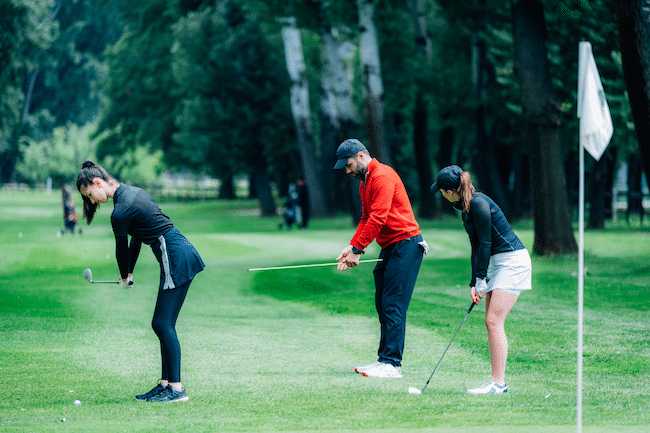Chipping is an essential part of any golfer’s game, and it’s no secret that a solid short game can be a game-changer out on the course. That’s where the top chipping drills can help.
Here are the 10 best chipping golf drills:
- The Ladder Drill
- The Tic-Tac-Toe Drill
- The Pillow Drill
- Chipping from the Rough Drill
- Chipping from Tight Lies Drill
- Chipping with Obstacles Drill
- The One-Handed Chipping Drill
- The Coin Drill
- The Eyes Closed Drill
- The Scored Chipping Drill
In this comprehensive guide, we’ll dive deep into the world of chipping golf drills, providing you with invaluable golf chipping tips and techniques to sharpen your skills around the greens.
We’ll cover everything from mastering the basics of chipping to exploring advanced drills for various golf scenarios. So, let’s get ready to elevate your short game to the next level!
The Basics of Chipping

To put it simply, chipping is played close to the green, where the ball is struck with a lofted club to make it lift into the air briefly and then roll toward the hole. Chipping involves a mix of technique, touch, and decision-making.
Having it in your arsenal can be highly beneficial as it helps you recover from those pesky missed greens and tricky lies near the green.
Importance of Club Selection
Choosing the right club for each chipshot is crucial. While wedges are the most common clubs for chipping, others like the 7-iron or 8-iron can also be used for bump-and-run chip shots.
The type of club you choose will dictate the trajectory and roll of the ball, so it’s essential to practice with various clubs to understand how each one affects your shots. By experimenting with different clubs, you’ll become more versatile and better prepared to handle various chipping situations on the course.
The Art of Visualization
Before executing a chip shot, visualize the trajectory and landing spot of the ball. This mental golf chipping practice helps you commit to the shot and improves your chances of executing it successfully.
Spend time visualizing different types of chip shots, such as high lofted shots or low bump-and-run shots, and imagine the path the ball will take as it flies through the air and rolls on the green.
This exercise helps you mentally prepare for various chipping scenarios and reinforces good technique and strategy.
Developing a Consistent Chipping Technique
Nailing consistency in chipping is a game-changer for your short game. Just remember: keep your stance stable, shift your weight a bit forward, and place your hands ahead of the ball.
Now, during that swing, keep those wrists sturdy and follow a smooth rhythm, allowing the club to work wonders. Stick to practicing; your chipping consistency will skyrocket before you know it.
Golf Chipping Tips
To execute a perfect chip shot, follow these tips:
- Use a narrow stance with your feet close together and your weight leaning towards your front foot.
- Place the ball in the center or slightly back in your stance.
- Maintain a straight left arm (for right-handed golfers) and a firm wrist through impact.
- Accelerate through the shot, ensuring a smooth and consistent tempo.
Read more: The 10 Best Golf Drills To Avoid Score-Killing Holes
Best Chipping Golf Drills for Beginners

Here are the best chipping drills golf offers, which we’ve listed below. Following these will help you bring out your ace game.
The Ladder Drill
This drill improves distance control by having you place several targets (towels, hula hoops, or golf clubs) at varying distances from you. Chip balls to each target, aiming to land the ball within the target area. As you become more proficient, challenge yourself by increasing the distances between targets or by chipping from different lies.
The Tic-Tac-Toe Drill
Draw a tic-tac-toe grid on the green using tees or string. Chip balls from different locations, aiming to land the ball in each square. This drill encourages precision and helps you understand how different lies and stances affect your chip shots.
The Pillow Drill
Place a pillow on the floor and chip balls as close to it as possible without touching it. The pillow helps with distance control, as it absorbs the ball’s energy if you do strike a few too hard.
Golf Chipping Drills for Different Lie Conditions
Golfers often encounter various lie conditions around the greens, and practicing chipping from different lies is crucial for developing a versatile short game.
Chipping from the Rough Drill
When chipping from the rough, you need to account for the thicker grass that may affect the club’s interaction with the ball. To practice this, place a towel or a similar object about 1-2 inches behind the ball and focus on making clean contact without disturbing the towel.
Repeat this drill several times, experimenting with different types of rough and lies to simulate actual course conditions.
As you become more comfortable chipping from the rough, you’ll be better equipped to handle these challenging situations during your rounds.
Chipping from Tight Lies Drill
Tight lies offer little margin for error, as the ball sits close to the ground with minimal grass underneath. To practice chipping from tight lies, place a ball on a tight lie and try to make contact with the bottom of the ball while brushing the ground gently.
Focus on keeping your hands ahead of the ball at impact and maintaining a shallow angle of attack. Perform this drill with various clubs to gain confidence and skill in handling tight lies.
Chipping with Obstacles Drill
Sometimes, you’ll need to chip over obstacles like bunkers, water hazards, or trees. Practice chipping over these obstacles by setting up targets at different heights and distances, simulating various scenarios you might encounter on the course.
Challenge yourself by creating shots that require a high loft or a low running trajectory.
By practicing these problematic shots, you’ll become more adept at handling complex chipping situations.
Chipping Drills for Improving Consistency and Confidence
To develop a consistent and reliable chipping game, it’s essential to practice drills that focus on building your confidence and maintaining a repeatable swing.
The One-Handed Chipping Drill
Focusing on your dominant hand, chip balls at a steady pace while ensuring a clean connection with the ball. This one-handed approach compels you to depend on proper body rotation and sound technique for successful execution.
Frequent practice of this drill will enhance your overall chipping consistency and reduce the use of hands and wrists in your technique.
The Coin Drill
Position a coin on the ground and aim to chip it into the air. Targeting a small object like a coin will draw your attention to solid ball contact. As your skill improves, try chipping the coin into a designated target area to refine your accuracy further.
The Eyes Closed Drill
Chip balls with your eyes closed to heighten your sense of touch and feel. This drill builds trust in your swing and improves your ability to make solid contact without relying solely on visual cues. Start with short chip shots and gradually progress to longer ones as you become more comfortable with the drill.
Practicing with your eyes closed will also help you better understand your swing mechanics and body movements during the chipping motion.
Chipping Strategies and Course Management
Effective chipping also involves intelligent course management and strategic thinking. This section will discuss some essential chipping strategies to help you make better decisions around the greens.
Assessing Your Lie
Before you chip in, take a moment to evaluate your lie. Is the ball sitting up or nestled down? Are there any obstacles you need to avoid? By assessing your lie, you can decide on club selection and shot execution.
Consider factors like the lie, green speed, and slope when planning your chip shot, and be prepared to adjust your strategy based on changing conditions during your round.
Choosing the Right Landing Spot
Selecting the ideal landing spot is crucial for a successful chip shot. When choosing your target, visualize the ball’s trajectory and consider the green’s slope and speed.
Remember that the ball will roll more on a downhill slope and less on an uphill slope, so adjust your landing spot accordingly.
Aim for a spot that allows the ball to land softly and roll towards the hole, taking advantage of the green’s contours whenever possible.
Developing a Go-To Chipping Shot
Having a go-to chipping shot in your arsenal can be a considerable advantage when faced with pressure situations. Practice a specific shot you feel confident in, and rely on it when unsure what to do.
This will help you maintain consistency and build confidence in your chipping game. Your go-to shot could be a high-lofted flop shot, a low bump-and-run, or a shot that utilizes your favorite club. The key is to have a reliable option you can execute under pressure.
Tips For Practicing Chipping Under Pressure
A surefire way to boost your chipping ability on the course is by recreating high-pressure scenarios during practice. This section will delve into some drills and methods for honing your skills under pressure.
The Scored Chipping Drill
Allocate point values to different targets on the practice green, striving to achieve a predetermined score within a specific number of shots.
This drill helps sharpen your focus on precision and accuracy while under pressure. To up the ante, set higher point targets or limit the number of allowed shots. By practicing with this goal-driven approach, you’ll excel at delivering top-notch chip shots when it counts.
Compete with Friends
Competing with friends or fellow golfers during practice adds an element of pressure and fun to your chipping sessions. Set up challenges or friendly wagers to keep things exciting and motivate you to perform your best.
Competitions can be based on accuracy, distance control, or overall chipping performance. The friendly competition will help you learn to manage your nerves and maintain focus during high-pressure situations on the course.
Visualize Pressure Situations
During practice, imagine yourself in high-pressure situations on the course, such as needing to get up and down to save par or chipping to win a tournament. This mental preparation will help you handle pressure when it counts the most.
By visualizing these scenarios, you’re training your mind to remain calm and focused, allowing you to execute your chip shots confidently and precisely.
How To Practice Chipping At Home
Practicing chipping at home is also essential for improvement. Here are some ideas on how to practice chipping at home:
Buy A Chipping Net
Setting up a chipping net in your backyard or garage is another great way to practice. Focus on chipping balls into the net with accuracy and consistency.
The Best Large Chipping Net:
The Best Small Chipping Net:
Setup A Backyard Chipping Course
Try creating a makeshift chipping course with various targets and obstacles in your backyard for those who like a challenge. After putting it through the test, we found that it can massively help you simulate real-course situations needed for successful chip shots.
Take Chipping Lessons
Taking chipping lessons from a golf professional can significantly improve your short game. They’ll help you develop proper chipping techniques, hone your skills, and provide personalized feedback to ensure you’re making progress. Not to mention, they can also help you identify and correct any bad habits that might be hindering your progress.
Learn Chipping from the Pros
Observing and learning from professional golfers is a great way to improve your chipping skills. Watch videos of top players executing chip shots, and pay attention to their technique, club selection, and decision-making processes.
Try incorporating these observations into your practice sessions and learn from their expertise. Look for patterns in their approach to chipping, such as how they address the ball, their swing tempo, and their choice of landing spots.
Emulating the pros can help you develop a more refined and effective chipping game.
Are Chippers Legal in Golf?
According to the United States Golf Association (USGA) and the R&A (the governing body for golf outside of the United States and Mexico), chippers are legal for use in golf as long as they conform to the equipment rules set forth by these organizations. The chipper should conform to guidelines concerning clubhead design, grooves, and overall club length.
It’s crucial to remember that a chipper will occupy one of the 14 club slots permitted in a golfer’s bag during a round, as mandated by the USGA and R&A rules. If you opt to include a chipper in your set, you’ll need to adjust your club choice to stay within the 14-club limit.
Pros and Cons of Using Chippers
We determined through our tests that chippers can aid golfers struggling with their short game by providing increased control and consistency around the greens. However, they may not be a perfect fit for every golfer, and some argue that mastering chipping with traditional wedges allows for greater versatility and shot options.
Ultimately, incorporating a chipper in your golf bag is a personal choice based on skill level, comfort, and individual preferences.
It’s essential to weigh the pros and cons and determine if using a chipper aligns with your golfing goals and style.
If you’re a beginner golfer looking to break 100 in golf, we at GolfSpan provide some helpful tips to improve your game.
Frequently Asked Questions
How Can I Add Spin To My Chip Shots?
To impart spin on your chip shots, make clean contact with a slightly descending strike, hitting the ball before the ground. Employing a high-lofted wedge with sharp grooves will also help create more backspin. Consistent practice is essential for mastering this skill, which demands exact technique and timing.
How Do I Control The Distance Of My Chip Shots?
Controlling the distance of your chip shots involves a combination of club selection, swing length, and swing speed. Experiment with different clubs and swing lengths during practice to develop a feel for controlling distance.
Additionally, sustaining a steady tempo and constant acceleration through the ball is vital for distance control.
What Is The Difference Between A Chip Shot And A Pitch Shot?
Chip shots are generally played close to the green, featuring a lower trajectory and more roll. In comparison, pitch shots are executed from greater distances with a higher trajectory and less roll.
Chip shots involve less wrist hinge and a shorter swing, while pitch shots demand more wrist hinge and an extended swing for increased height and spin.
How Do I Choose The Right Club For Chipping?
The ideal club for chipping depends on your lie, hole distance, and available green space. For a shot with more roll and less carry, use a lower-lofted club like a 7-iron or 8-iron.
Conversely, use a higher-lofted club like a sand wedge or lob wedge for more carry and less roll. Experiment with different clubs during practice to find the best ones for various situations.
How Often Should I Practice My Chipping Drills For Golf?
We recommend you practice your chipping drills for at least 30 minutes each practice session. This frequency can vary depending on your skill level and goals, but dedicating consistent time to chipping will help you develop better feel, touch, and accuracy around the greens.
However, don’t just focus on the time; try to develop an intuition of the “perfect chipping shot.” As you continue practicing, this will come off naturally.
Conclusion
Improving your chipping game through dedicated practice and intelligent strategy can significantly lower your scores and enhance your overall golfing experience.
You’ll become a more skilled and confident golfer around the greens by mastering chipping golf drills, adapting your technique to various golf scenarios, and learning from the pros. Remember, consistent practice is essential for chipping mastery.
Be patient with your progress as you hone your chipping abilities and continue challenging yourself.
Establish personal objectives and celebrate your accomplishments as you advance. You’ll soon observe significant improvements in your short game, resulting in reduced scores and a more pleasurable golf experience.
Clint is PGA-certified and was a Head Teaching Professional at one of Toronto's busiest golf academies. He was also featured on Canada's National Golf TV program, "Score Golf Canada," twice. He graduated with a degree in Golf Management from the College of the Desert in California and studied under Callaway's co-founder, Tony Manzoni. He has a handicap index of 6.2 and spends the winters near Oaxaca, Mexico, where he plays twice a month at the Club de Golf Vista Hermosa. He's written over 100 articles at GolfSpan since 2021. You can connect with Clint at LinkedIn, FB, his website, or Clintcpga@gmail.com.








